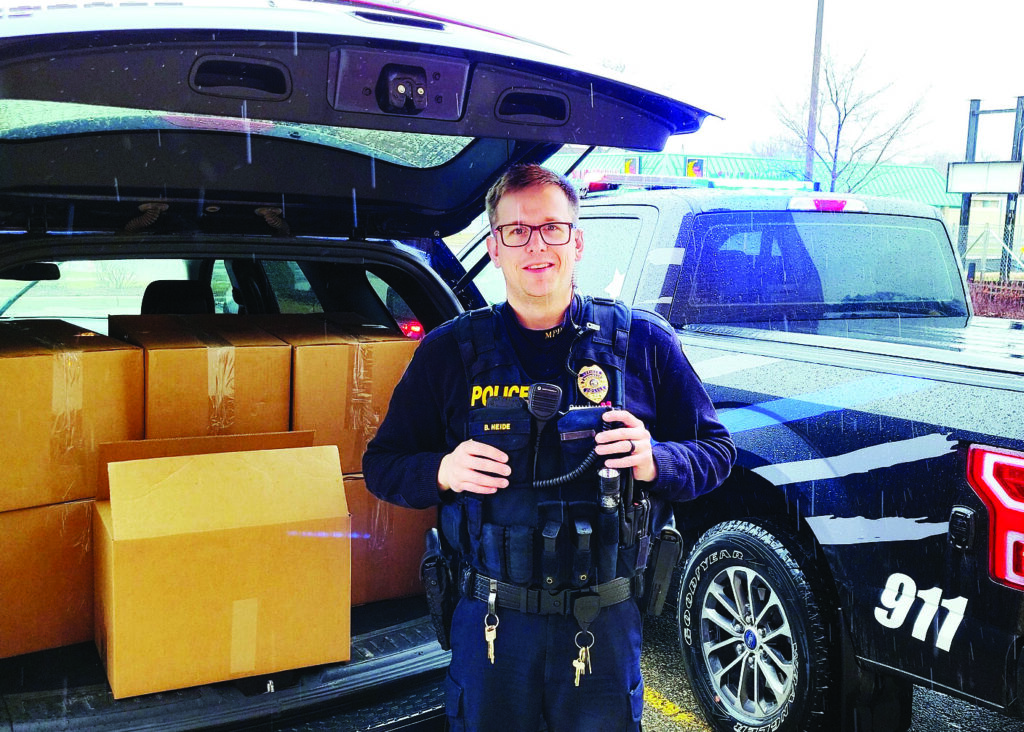
School Resource Officer Brandon Heide collected 111 pounds of discarded prescription and over-the-counter drugs at the Moorhead Police Department’s first Drug Take-Back event last year at the Azool Hornbacher’s. The next Take-Back is scheduled for April 22 at Hornbacher’s.
Nancy Edmonds Hanson
Prescription medicines sometimes linger far longer than the illness that inspired them. But, shoved to the back of the bathroom cabinet, they’re more than a historical record of past aches and pains … they can become a risk far beyond the patient for whom they were prescribed.
What to do with them? That’s one of the dilemmas that the Moorhead Police Department can help solve, along with others concerned with disposal of no-longer-needed pharmaceuticals.
The nationwide Drug Take-Back program of the Drug Enforcement Administration is the most visible option. According to community services coordinator Leann Wallin, the local police department has joined with counterparts around Clay County, the state of Minnesota and nationwide in its annual Drug Take-Back events, usually staged twice per year in prominent locations.
Generally staffed by Moorhead’s school resource officers, the events – typically at Hornbacher’s supermarkets – offer a convenient way to drop off the remainder of past prescriptions. The next local take-back event is planneed for April 22 at the Azool Hornbacher’s. The most recent event last October gathered 187 pounds of pills and medicines.
But there are other options. One is the drug-drop safe box in the entrance of the Law Enforcement Center, a secure depository that’s accessible year-round. A total of 367 pounds of unwanted, unneeded pharmaceuticals were collected there last year and, like the “harvest” at the Take-Backs, were forwarded to the DEA for safe disposal.
The Clay County Sheriff’s Department provides similar secure sites in other Clay County cities, including the police departments in Dilworth, Glyandon, Hawley, Barnesville and Ulen. Most are accessible during business hours. The Dilworth safe, located in the police department lobby, is available after hours as well.
Pharmacy and public health professor Oliver Frenzel, who keynoted the “9-1-1 What’s Your Emergency” session sponsored by Triad next Wednesday, suggests several other opportunities. “Pharmacies will generally accept left-over prescriptions for safe disposal,” he says.
There are at-home options, too. Drugs should never be tossed into the trash or flushed down the toilet, he warns. In the latter case, they dissolve and find their way into rivers, lakes, wastewater treatment plants and septic systems, where they harm the environment. “Minnesota has conducted numerous studies that detected pharmaceutical chemicals in its waters,” he points out. Widely dispersed in the ecosystem, they harm the small organisms that live in the water and the fish and birds that feed on them.
Both commercial and do-it-yourself methods can be used for harm-free disposal. Commercial disposal kits – widely available in pharmacies — include packets and powder. The pills are packaged; then the powder is added, along with water, and the combination is smooshed.. It turns into a sludge that can be safely thrown away with other trash.
There’s an inexpensive alternative, too. “Put your medication in a baggie, then fill it with wet coffee grounds or kitty litter,” he advises. That, too, creates sludge that can added to household garbage bins, posing no risk to the environment.


